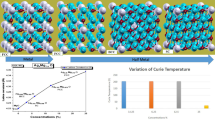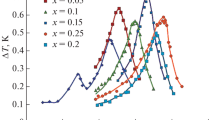Abstract
We demonstrate that DFT calculations performed with the local density approximation (LDA) allow for significantly better reproduction of lattice constants, the unit cell volume and the density of Ag(II)SO4 than those done with generalized gradient approximation (GGA). The LDA+U scheme, which accounts for electronic correlation effects, enables the accurate prediction of the magnetic superexchange constant of this strongly correlated material and its band gap at the Fermi level. The character of the band gap places the compound on the borderline between a Mott insulator and a charge transfer insulator. The size of the band gap (0.82 eV) indicates that AgSO4 is a ferrimagnetic semiconductor, and possibly an attractive material for spintronics. A bulk modulus of 27.0 GPa and a compressibility of 0.037 GPa–1 were determined for AgSO4 from the third-order Birch–Murnaghan isothermal equation of state up to 20 GPa. Several polymorphic types compete with the ambient pressure P-1 phase as the external pressure is increased. The P-1 phase is predicted to resist pressure-induced metallization up to at least 20 GPa.

Despite its more simplified character, the local density approximation allows for much better reproduction of many microscopic parameters of Ag(II)SO4 than the more sophisticated generalized gradient approximation





Similar content being viewed by others
Notes
U is a quasi-arbitrary parameter. It is a common practice to vary U over a broad energy range when trying to reproduce either a crystal structure, magnetic moments, or a band gap, etc. Unfortunately, different U values will perform best for each of these properties. In addition, in most cases, unrealistically large values of U are needed to make the band gap broad enough to match the experimental value. With this in mind, we have decided to use certain arbitrarily chosen U values. A typical value for Cu(II) is 9–10 eV, and it is reduced considerably if one moves to the next period (larger, softer cation). The values of U and J used in this paper for Ag(II) have in the past yielded reliable results for other compounds of Ag(II), such as KAgF3 and both polymorphic forms of K2AgF4 [8, 9]. In particular, the crystal and electronic structures of Cs2AgF4 have been screened very carefully by a number of theoretical groups, and the values of U and J used in these works for Ag match our values well. Concerning the oxide dianion, it is reasonable to assume that strong correlations are comparable to those for the isoelectronic fluoride one. In this way, we can improve the description of electronic correlation compared to that usually employed for, say, oxocuprates, where U is typically set for a transition metal only.
Sometimes LDA outperforms GGA in the prediction of lattice constants and dynamic properties, as found, for example, for alkali metal hydrides [12].
It also turns out that also the phonon spectra of AgSO4 are reproduced by LDA calculations with excellent accuracy (Derzsi M et al., submitted to Vibr Spectrosc).
References
Grochala W, Hoffmann R (2001) Angew Chem Int Ed 40:2743–2781
Grochala W (2003) ChemPhysChem 4:997–1001
McLain SE (2006) Nat Mater 5:561–566
Grochala W (2006) Nat Mater 5:513–514
Malinowski PJ, Derzsi M, Gaweł B, Łasocha W, Jagličić Z, Mazej Z, Grochala W (2010) Angew Chem Int Ed 49:1683–1686
Blöch PE (1994) Phys Rev B 50:17953–17979
Kresse G, Furthmüller J (1996) Phys Rev B 54:11169–11186
Mazej Z, Goreshnik E, Jagličić Z, Gaweł B, Łasocha W, Grzybowska D, Jaroń T, Kurzydłowski D, Malinowski PJ, Koźminski W, Szydłowska J, Leszczyński P, Grochala W (2009) Cryst Eng Comm 11:1702–1710
Kurzydłowski D, Derzsi M, Budzianowski A, Jagličić Z, Koźminski W, Mazej Z, Grochala W (2010) Eur J Inorg Chem 2919-2925
Noodleman L, Norman JG (1979) J Chem Phys 70:4903–4906
Derzsi M, Dymkowski K, Grochala W (2010) Inorg Chem 49:2735–2742
Barrera GD (2005) Chem Phys 317:119–129
Murnaghan FD (1944) Proc Nat Acad Sci 30:244–247
Birch F (1947) Phys Rev 71:809–824
Kumar M (1996) Phys Status Solidi B 196:209–212
Romiszewski J, Grochala W, Stolarczyk L (2006) J Phys Condens Matter 19(13):116206
Johnson M, Silsbee RH (1985) Phys Rev Lett 55:1790–1793
Reinert F, Steiner P, Hufner S, Schmitt H, Fink J, Knuofer M, Sandl P, Bertel E (1995) Z Phys B 97:83–93
Grochala W, Feng J, Hoffmann R, Ashcroft NW (2007) Angew Chem Int Ed 46:3620–3642
Bartels RA, Smith PA (1973) Phys Rev B 7:3885–3892
Liu ZJ, Du YX, Zhang XL, Qi JH, Tian LN, Guo Y (2010) Phys Status Solidi B 247:157–162
Gilev SD, Trubachev AM (1999) Phys Status Solidi B 211:379–383
Fukunaga O, Yamaoka S (1979) Phys Chem Miner 5:167–177
Acknowledgments
The project “Quest for Superconductivity in Crystal-Engineered Higher Fluorides of Silver” is operated by the Foundation for Polish Science’s TEAM program, and co-financed by the EU European Regional Development Fund.
Author information
Authors and Affiliations
Corresponding author
Additional information
Dedicated to the memory of Professor Andrzej Sadlej, an outstanding Polish quantum chemist.
Rights and permissions
About this article
Cite this article
Derzsi, M., Stasiewicz, J. & Grochala, W. Crystal and electronic structures and high-pressure behavior of AgSO4, a unique narrow band gap antiferromagnetic semiconductor: LDA(+U) picture. J Mol Model 17, 2259–2264 (2011). https://doi.org/10.1007/s00894-010-0950-y
Received:
Accepted:
Published:
Issue Date:
DOI: https://doi.org/10.1007/s00894-010-0950-y




